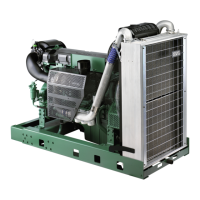Do you have a question about the Volvo Penta TAD1651VE and is the answer not in the manual?
Discusses fire and explosion risks associated with fuels and batteries, emphasizing ventilation.
Emphasizes using genuine Volvo Penta parts for safety and to prevent explosions or fires.
Outlines safety procedures before starting the engine and stresses ventilation.
Warns about dangers from moving engine components and hot surfaces.
Prohibits the use of start spray due to explosion risk in the inlet manifold.
Lists critical checks and precautions before starting the engine.
Details safety steps for working on the engine's electrical system.
Warns about hazards during welding and working on the cooling system.
Warns about burns from hot coolant and oil, and pressure release procedures.
Highlights refueling risks and emphasizes proper fuel quality for engine health.
Notes legal requirements for fuel to meet emission standards.
Advises caution and eye protection when checking for fuel leaks due to high pressure.
Instructs on fuel pipe handling and battery safety, including polarity.
Prohibits high-pressure washers and emphasizes component cleanliness.
Explains EMS input/output, fuel regulation, and diagnostic functions.
Details DCU functions for preheating, governor modes, and fault diagnostics.
Provides a checklist of crucial pre-start checks for the engine and engine compartment.
Critical warning against using start spray due to explosion risk.
Offers preparation advice for starting the engine in very cold temperatures.
Repeats the warning against using start spray due to explosion hazard.
Provides instructions for starting the engine using auxiliary batteries, including safety precautions.
Details the procedure for running the engine at high idle before shutdown for cooling and data saving.
Provides step-by-step instructions for stopping the engine using the DCU panel.
Explains the purpose of the diagnostic function in monitoring, controlling, and protecting the engine.
Provides a table of symptoms and possible causes for engine malfunctions.
Continues the list of symptoms and possible causes for engine malfunctions.
Lists SPN, PID, PPID, SID, PSID, Flash code, and FMI for engine parameters.
Continues the table listing fault codes, components, and FMI codes.
Continues the table listing fault codes and components.
Emphasizes reading safety advice before commencing maintenance tasks.
Warns that care and maintenance should be performed with the engine stopped.
Details how to check and maintain the engine oil level using the dipstick.
Provides instructions for changing the engine oil, including safety precautions.
Guides on how to clean and replace the oil filters.
Guides on checking and topping up the engine coolant level.
Critical safety warning before performing any work on the engine's electrical system.
Covers battery safety warnings, handling, and maintenance recommendations.
Provides instructions for safely replacing the battery, including disconnection and connection procedures.
Advises reading maintenance instructions and warns about conservation oil hazards.
Discusses fire and explosion risks associated with fuels and batteries, emphasizing ventilation.
Emphasizes using genuine Volvo Penta parts for safety and to prevent explosions or fires.
Outlines safety procedures before starting the engine and stresses ventilation.
Warns about dangers from moving engine components and hot surfaces.
Prohibits the use of start spray due to explosion risk in the inlet manifold.
Lists critical checks and precautions before starting the engine.
Details safety steps for working on the engine's electrical system.
Warns about hazards during welding and working on the cooling system.
Warns about burns from hot coolant and oil, and pressure release procedures.
Highlights refueling risks and emphasizes proper fuel quality for engine health.
Notes legal requirements for fuel to meet emission standards.
Advises caution and eye protection when checking for fuel leaks due to high pressure.
Instructs on fuel pipe handling and battery safety, including polarity.
Prohibits high-pressure washers and emphasizes component cleanliness.
Explains EMS input/output, fuel regulation, and diagnostic functions.
Details DCU functions for preheating, governor modes, and fault diagnostics.
Provides a checklist of crucial pre-start checks for the engine and engine compartment.
Critical warning against using start spray due to explosion risk.
Offers preparation advice for starting the engine in very cold temperatures.
Repeats the warning against using start spray due to explosion hazard.
Provides instructions for starting the engine using auxiliary batteries, including safety precautions.
Details the procedure for running the engine at high idle before shutdown for cooling and data saving.
Provides step-by-step instructions for stopping the engine using the DCU panel.
Explains the purpose of the diagnostic function in monitoring, controlling, and protecting the engine.
Provides a table of symptoms and possible causes for engine malfunctions.
Continues the list of symptoms and possible causes for engine malfunctions.
Lists SPN, PID, PPID, SID, PSID, Flash code, and FMI for engine parameters.
Continues the table listing fault codes, components, and FMI codes.
Continues the table listing fault codes and components.
Emphasizes reading safety advice before commencing maintenance tasks.
Warns that care and maintenance should be performed with the engine stopped.
Details how to check and maintain the engine oil level using the dipstick.
Provides instructions for changing the engine oil, including safety precautions.
Guides on how to clean and replace the oil filters.
Guides on checking and topping up the engine coolant level.
Critical safety warning before performing any work on the engine's electrical system.
Covers battery safety warnings, handling, and maintenance recommendations.
Provides instructions for safely replacing the battery, including disconnection and connection procedures.
Advises reading maintenance instructions and warns about conservation oil hazards.
| Engine Model | TAD1651VE |
|---|---|
| Manufacturer | Volvo Penta |
| Number of Cylinders | 6 |
| Emission Compliance | EU Stage V |
| Engine Type | Diesel |
| Aspiration | Turbocharged |
| Bore x Stroke | 144 mm x 165 mm |
| Torque | 700 Nm |
| Fuel System | Common Rail |
| Cooling System | Freshwater |
| Aftertreatment | SCR |











